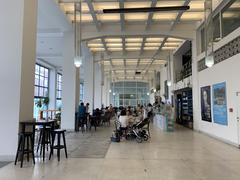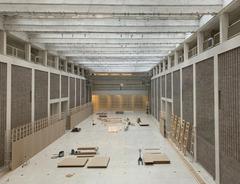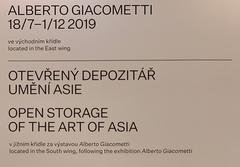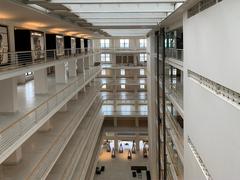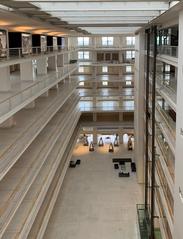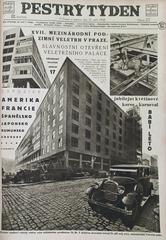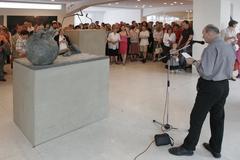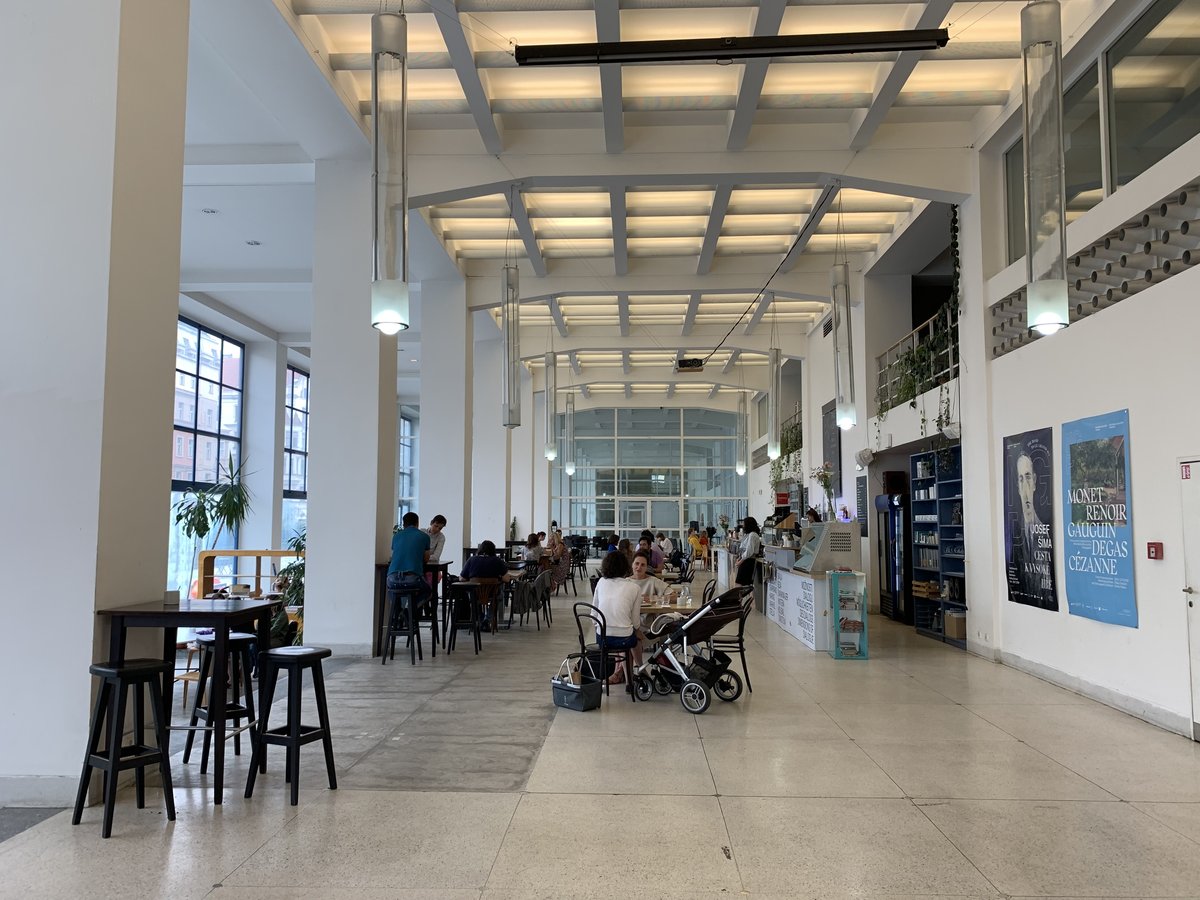
Trade Fair Palace Prague Visiting Hours, Tickets, and Historical Sites Guide
Date: 14/06/2025
Introduction to Trade Fair Palace in Prague
Nestled in Prague’s lively Holešovice district, the Trade Fair Palace (Veletržní palác) is a monumental landmark of early 20th-century Czech functionalism. Designed between 1925 and 1928 by Josef Fuchs and Oldřich Tyl, the palace was conceived as a hub for international trade fairs, symbolizing the optimism and industrial progress of interwar Czechoslovakia. Its pioneering use of reinforced concrete, expansive glass façades, and open-plan interiors marked a decisive shift in Czech architecture, moving away from ornate historicism towards modernist rationality and utility.
Over time, the palace has undergone significant transformations—from serving as a bustling center for commerce, enduring wartime repurposing, surviving a devastating fire in 1974, to its restoration and adaptive reuse as the National Gallery Prague’s premier venue for modern and contemporary art. Today, it houses over 13,000 square meters of exhibition space and more than 2,000 works by Czech and international masters.
This guide offers essential information on visiting hours, ticketing, accessibility, and nearby attractions, along with tips for guided tours and photography to help you make the most of your visit. For additional insights, see the National Gallery Prague official website, Prague.eu, and Expats.cz.
Table of Contents
- Origins and Architectural Vision
- Historical Transformations and Restoration
- Museum Collections and Exhibitions
- Visitor Information
- Nearby Attractions
- FAQs
- Conclusion
- Sources
Origins and Architectural Vision
The Trade Fair Palace was conceived as a center for international trade fairs and exhibitions, reflecting the industrial optimism of interwar Czechoslovakia. Built by Josef Fuchs and Oldřich Tyl, the structure features reinforced concrete, eight above-ground floors, and two subterranean levels, setting a new standard for Czech functionalist architecture. Its clean lines, open-plan interiors, and extensive use of glass and steel distinguish it from Prague’s more ornate buildings (Expats.cz).
Historical Transformations and Restoration
During World War II, the palace was tragically repurposed as a gathering site for Prague’s Jewish population before deportations (prague-now.com). After the war, it served as offices under the communist regime. In 1974, a fire severely damaged the building, but restoration efforts beginning in 1976—culminating after the Velvet Revolution—transformed it into the National Gallery’s modern art center by 1995 (Expats.cz).
Museum Collections and Exhibitions
Permanent Collections
The palace houses more than 2,000 works spanning the 19th to 21st centuries, including masterpieces by Czech artists such as František Kupka, Alfons Mucha, Toyen, Emil Filla, and Otto Gutfreund. International highlights include works by Picasso, Van Gogh, Monet, Cézanne, Renoir, Klimt, Braque, and Munch (prague-now.com, danielasantosaraujo.com).
Architecture & Design
The palace’s column-free halls and glass atrium provide a dramatic setting for large-scale art, architecture, and design exhibitions. Temporary exhibitions showcase contemporary art and design, while architectural models offer insight into Prague’s creative evolution.
Current and Upcoming Exhibitions
- ATLAS (2022–2027): Examines intersections of art, history, and society.
- Silent Spring — Art and Nature 1930–1970 (March–August 2025): Explores art’s engagement with environmentalism.
- Echoes of the Venice Biennale — Eva Koťátková (March–July 2025): Features contemporary Czech art.
- 1918–1938: The First Czechoslovak Republic: Showcases interwar cultural developments.
- 1796–1917: Art of the Long Century: Traces the roots of Czech modernism.
- 1956–1989: Architecture for All: Highlights postwar architectural innovation (prague.eu).
Visitor Information
Visiting Hours & Tickets
- Open: Tuesday to Sunday, 10:00 AM – 6:00 PM (extended to 8:00 PM on the first Wednesday of each month)
- Closed: Mondays
- Tickets: Standard adult 250–350 CZK, reduced tickets for students/seniors, and free admission for children under 15. Special free admission on February 5th (National Gallery anniversary). Purchase at the entrance or online (official website).
Accessibility & Getting There
- Address: Dukelských hrdinů 47, Prague 7, Holešovice
- Metro: Line C (Vltavská station)
- Tram: Lines 1, 6, 12, 17, 25 (Veletržní palác stop)
- Wheelchair accessibility: Elevators and ramps throughout. Assistance is available on request.
Amenities & Services
- Cloakroom and restrooms on each floor
- Gift shop with art books, prints, and souvenirs
- Rooftop café for refreshments and city views
- Free Wi-Fi in public areas
Guided Tours & Events
- Guided tours in Czech and English; recommended for architectural and art insights (events calendar).
- Educational workshops for all ages
- Special events: Free Admission Day on February 5th and Open House Prague in May (insightcities.com).
Photography Tips
- Non-flash photography is generally permitted, but flash and tripods are not allowed. The central atrium and glass elevators offer excellent natural-light photo opportunities.
Nearby Attractions
- Stromovka Park: Expansive green space, ideal for a stroll.
- Prague Zoo: Popular family attraction nearby.
- National Technical Museum and National Agriculture Museum: Both within walking distance.
- Vnitroblock: Creative hub with cafés and shops.
Frequently Asked Questions (FAQ)
Q: What are the Trade Fair Palace visiting hours?
A: Open Tuesday to Sunday, 10:00–18:00; extended to 20:00 on the first Wednesday of each month.
Q: How do I buy tickets?
A: Purchase at the entrance or online via the official website.
Q: Is the Trade Fair Palace accessible?
A: Yes, with elevators and ramps throughout.
Q: Are guided tours available?
A: Yes, in Czech and English. Schedule varies; check the events calendar.
Q: Can I take photographs inside?
A: Non-flash photography is generally allowed. Observe signage for any restrictions.
Q: Is there a café or shop on-site?
A: Yes, a rooftop café and a gift shop are available.
Conclusion
The Trade Fair Palace is much more than an architectural icon; it is a living chronicle of Czech history, culture, and artistic evolution. From its origins as a beacon of industrial ambition to its transformation into a world-class museum, the palace embodies Prague’s creativity and resilience. Its functionalist design continues to inspire, while its collections offer a journey through Czech and international art. Plan ahead by checking updated visiting hours, ticket options, and events on the National Gallery Prague website, and take advantage of guided tours for deeper insights. Don’t miss nearby attractions, and be sure to bring your camera for stunning architectural photos.
For audio guides, up-to-date visitor information, and more travel tips, download the Audiala app. Explore related articles on Prague’s historical sites and modern architecture for a richer cultural experience.
Sources and Further Reading
- This is a sample text. (Expats.cz)
- This is a sample text. (Czech Journal)
- This is a sample text. (prague-now.com)
- This is a sample text. (National Gallery Prague)
